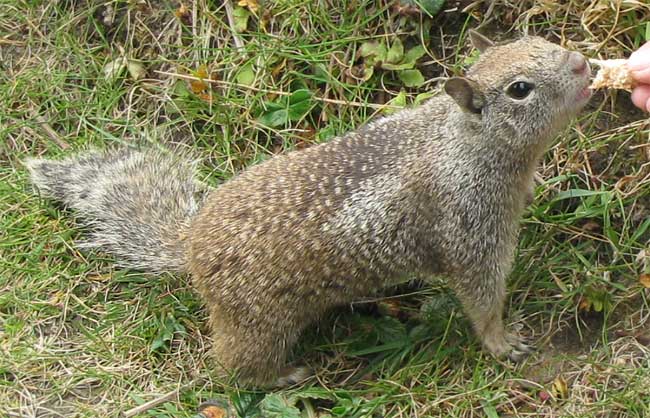Excerpts from Jim Conrad's
Naturalist Newsletter

from the May 17, 2009 Newsletter, issued from the Siskiyou Mountains west of Grants Pass, Oregon:
DOUGLAS'GROUND SQUIRREL
By scenic mountain roads the Pacific Ocean lies only a couple of hours west of here. Last weekend my friends took me there for a look, to Harris Beach State Park in Brookings four or five miles north of the California border. It was chilly and so foggy you couldn't see far offshore, but I was glad to be back on the ocean, to smell it, hear it, to be chased back and forth by its waves.
On a rocky cliff overlooking the sandy beach I spotted a small, squirrelly mammal emerging from its burrow and was tickled when I could sneak close enough for a picture. I clicked the shutter, then moved closer for another, and still my quarry didn't move. Fantastic! And then another, and a little closer and what a thrill to get fifteen feet away! Then Anita came up behind me and said, "It'll eat from your hand, you know... "
Well, the last time I saw this species, in the Sierra Nevadas back in 2005, I worked hard to get close enough to identify it with binoculars. So, no, I hadn't known it'd eat from your hand. Anita retrieved bread from the car, sat on a rock, held her hand toward our visitor, and as the critter snatched a crumb from her hand I snapped the picture at the top of this page:
That's a California Ground Squirrel, SPERMOPHILUS BEECHEYI*, distributed from western Washington and Oregon through California to northern Baja, Mexico. Its spottiness, its silvery back, shoulders and side, its bushy tail, and its presence on the ground instead of a tree are good field marks. Oregon is home to eight ground-squirrel species (eight species of the genus Spermophilus) but this is the only one in the state's southwestern corner, the others residing at higher elevations farther east.
Before long four squirrels were eating from Anita's hand. They'd emerge from burrows in soft soil at a boulder's base, snatch the bread, chew on it briefly, store it in their cheek pouches, then with comically bulging cheeks rush back for more.
Rattlesnakes are the ground squirrels' arch enemy. Here's some interesting info about that found on the Internet:
First, some populations of California Ground Squirrels show varying levels of immunity to rattlesnake venom as adults. Female squirrels with pups may chew on shed rattlesnake skins, then lick themselves and their pups to disguise their scent. When they kick sand at a rattlesnake it provokes the snake to rattle its tail, and that helps the squirrel assess the snake's size and temperament, and maybe to distract it from a den with pups. A squirrel might also swish its tail so vigorously that the tail "super-heats." Since a rattlesnake finds its prey mainly by using infrared, heat-sensitive sensors in the pits between its eyes and nostrils, a squirrel's overheated tail suggests to a snake that the squirrel is much larger than it really is, so the snake may decide that attacking this critter is too dangerous.
from the September 11, 2005 Newsletter, issued from the Sierra Nevada Foothills east of Sacramento, California:
CALIFORNIA GROUND SQUIRRELS
At about 4300 feet in elevation I took a rest, perching on a stump atop a steep slope below which nothing remained of the clearcut forest other than rotting stumps, eroding dirt and brush piles. The glare and afternoon heat were bad but I'd spotted movement down below and I wanted to know what critter could possibly call such a raw, broken landscape home. Eventually he appeared, sprinting from beneath a log to grab something in the open, maybe a beetle, and quickly return to his hiding.
He looked a like a chickaree -- which looks like a small gray squirrel -- but I'd never seen a chickaree far from a standing tree.
The binoculars explained it. Here was something different, something gray with a broad, pale splotch on each side along the neck and above the shoulders. He was a California Ground Squirrel, CITELLUS BEECHEYI. During the rest of the hike I spotted quite a few California Ground Squirrels, though never in the forest, just in open and semi-open areas. Though this preference for the ground set him apart from chickarees and tree squirrels, his outward similarity to those animals got me to wondering just what was the difference between them.
My field guide wasn't much help. In fact, it added marmots, woodchucks and prairie dogs to the mix, because those animals are members of the Squirrel Family, the Sciuridae, just like tree squirrels, chipmunks and these ground squirrels. Thumbing through the field guide's illustrations of the various Squirrel Family members I decided that just from outward appearances the various groupings more or less blend into one another. If all you know is the Eastern Chipmunk and the Eastern Gray Squirrel there's a world of difference between those two things, but consider all the other species in the family and it becomes hard to draw lines between major groupings, at least by outward appearances alone.
Ground squirrels and chipmunks do possess thin inner cheek pouches for carrying food or nest material, but tree squirrels, including the Chickaree, don't. This is a big anatomical difference but you can't see it from the outside. Also there are striking differences of behavior, but a picture doesn't show that, either. The ground-dwelling species even have the nice habit of rearing up on haunches and looking around, just like tree squirrels on a limb.
The Sierra Nevada Natural History handbook says that at one time California Ground Squirrels were "enormously abundant," even in the Central Valley below. However, these rodents dig tunnels that can break a cow's leg and they relish the irrigated crops grown down there, so the species has been exterminated over large tracts. Still, here and there in the Sierras they are represented "scatteringly well," as the handbook says.